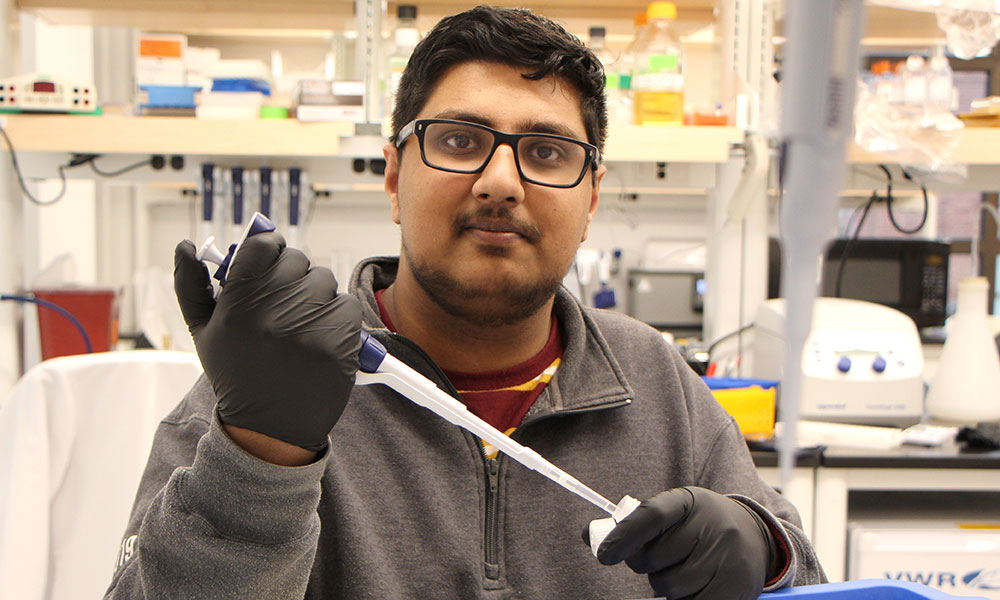Just one year after joining MCB faculty Amanda Whipple’s team, research assistant Udbhav Chitta has gone from RNA biology newbie to official co-author on a new paper that debuted in the journal Molecular Cell this week.
The 22-year-old research assistant (RA) says of being a co-author on a paper: “It’s nice. I’m not going to downplay that…It means you contributed to a new finding and were able to participate in hypothesis-based research and be at the forefront of science.”
Though RNA biology is a relatively new interest, Chitta has been building toward a scientific career from a young age. He was born in Guntur, India in the state of Andhra Pradesh but grew up in the United States, living what he calls a “tri-coastal life.” His family moved often—spending a few years apiece in Austin, Buffalo, Cambridge, Worcester, and San Diego—due to his father’s job as an immunologist.
Despite having a scientist parent, Chitta says his family was hesitant to encourage him to pursue science. “Being an immigrant and doing your scientific training in another country and then coming to the US is oftentimes tough, and making it big is oftentimes even more difficult,” Chitta says. “So they were always very wary of that.”
Still, as a teenager in San Diego in the early 2010s, he was intrigued by science news stories about biology and genomics. At the same time, he realized that his efforts as on the school robotics team probably wouldn’t turn into a career. “My dad always told me, ‘Do whatever you want, but just make sure you’re good at it,’” Chitta says. “And that’s what I ran with.”
So the high school student cold-emailed dozens of professors at nearby institutions asking for an opportunity to work in their labs. Anjana Rao of the La Jolla Institute for Allergy & Immunology took him up on the offer. Chitta says his time in her lab instilled the importance of networking, immersive lab experience, and being scientifically inquisitive.
After graduating from high school in 2015, Chitta headed to Northeastern University, largely because of the vibrant research communities in and around Boston. He became a research assistant in Jay Rajagopal’s lab at MGH and the Harvard Stem Cell Institute, where he conducted experiments with neuroendocrine cells. (That effort earned him another co-authorship on a paper currently in submission.) Through Northeastern’s semester-long co-op program, he also spent time working at the CRISPR therapeutics company Editas and the antibody therapeutics company Visterra.
He began working with Whipple in early 2019, while she was a postdoc in Phil Sharp’s lab at MIT. “I interviewed over the phone with Amanda, and I instantly was captivated by how she described her work,” Chitta recalls. “Not only that, you could hear her enthusiasm through the phone.”
Whipple’s research investigates a unique group of genes called non-coding, imprinted genes. In these genes, offspring inherit two versions of the gene—one from each parent—but only express one of the two alleles. Many imprinted genes encode small RNAs with unknown functions, so Whipple and her colleagues study the behavior and effects of these small RNAs.
When Chitta met her, Whipple was finishing the project that would become the Molecular Cell paper. The research focused on an imprinted region of the genome called Mirg, which lies within a larger imprinted gene called Meg3. Whipple’s team had already completed an experiment where they deleted the Mirg locus from a line of lab-grown neural cells and compared them to control cells with the Mirg locus intact. “The difference between the control Mirg locus and the deleted Mirg locus was that you saw a lot of genes significantly increase in expression [in the cells without Mirg],” Chitta explains. That increased gene expression led to more synaptic firing, Whipple’s experiments found.
This evidence suggested that microRNA transcripts of maternally-inherited Mirg genes were somehow repressing certain genes inherited from the father. But Whipple’s team wanted to establish whether the Mirg microRNAs were attacking messenger RNA copies of paternally-expressed genes.
“We wanted additional evidence that this interaction was direct,” Whipple explains. “So Udbhav helped design and independently performed a series of luciferase reporter experiments which showed the interaction was direct. Because this experiment was critical to our study, Udbhav was added as a co-author.”
When Whipple joined the MCB faculty, Chitta decided to go with her as a research assistant and learn more about genetics before heading to graduate school. He’s currently considering where he wants to apply and says that Harvard’s MCO program is near the top of his list, along with Stanford and University of Washington in Seattle.
When he’s not in the lab, Chitta enjoys hanging out with his friends, drawing, and freestyle rapping. He also helped found an educational tech company called Tooople. “I think being an RA gives me an opportunity to learn how to develop a work-life balance while also doing pretty intense research,” he says. “I feel like if I take these lessons to heart, it’ll help me become a better researcher in the future.”
by Diana Crow


